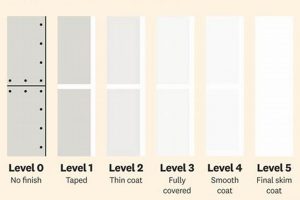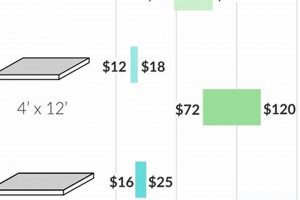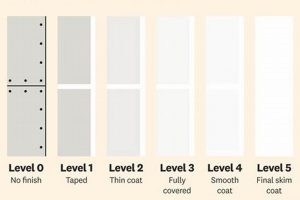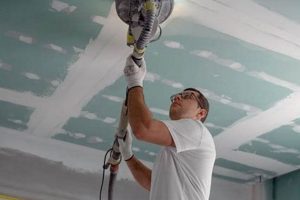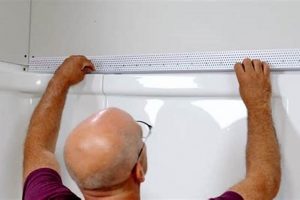The process of concealing seams and creating a smooth, right-angled intersection where two drywall panels meet at an interior angle is a critical step in wall construction. Accomplishing this properly ensures a seamless aesthetic between adjacent wall surfaces. A common example involves the juncture of two walls in a room, typically at a 90-degree angle.
Achieving a well-executed junction is paramount for both visual appeal and structural integrity. A poorly finished area can be susceptible to cracking and may detract significantly from the overall finish of a room. Historically, various techniques have been employed to address this construction detail, with modern methods focusing on durable and aesthetically pleasing solutions. The result is a polished look that enhances property value and creates a comfortable living space.
The subsequent sections will detail the specific materials, tools, and step-by-step procedures involved in achieving a professional-grade finish, focusing on best practices for preparation, application, and final smoothing.
Expert Insights for Drywall Interior Angle Finishing
Achieving a professional-grade result in drywall interior angle completion requires meticulous attention to detail and adherence to proven techniques. These tips provide guidance for avoiding common pitfalls and ensuring a durable, aesthetically pleasing outcome.
Tip 1: Utilize high-quality joint compound formulated for taping. This provides enhanced adhesion and crack resistance specifically suited for interior angles.
Tip 2: Employ paper drywall tape instead of fiberglass mesh tape. Paper tape offers superior strength and is less prone to cracking along the angle.
Tip 3: Apply a thin, even coat of joint compound beneath the paper tape. This ensures proper bonding and minimizes air pockets that can lead to future imperfections.
Tip 4: Embed the paper tape firmly into the compound using a taping knife, removing excess compound and creating a smooth, consistent surface.
Tip 5: Allow each coat of joint compound to dry completely before applying the next. Rushing the drying process can compromise the integrity of the finish.
Tip 6: Sand lightly between coats using a fine-grit sanding sponge. This smooths out imperfections and creates a better surface for subsequent coats.
Tip 7: Apply multiple thin coats of joint compound rather than one thick coat. This minimizes the risk of cracking and facilitates easier sanding.
Consistent application of these insights results in strong, smooth, and visually appealing interior angles that enhance the overall quality of the drywall finish. Proper attention to detail significantly reduces the likelihood of future repairs and ensures a lasting, professional result.
The concluding section will recap key steps and offer additional resources for continued learning and mastery of drywall finishing techniques.
1. Preparation Is Paramount
The success of achieving professionally finished drywall interior angles is inextricably linked to meticulous preparatory work. The axiom “Preparation Is Paramount” underscores the critical importance of this stage in the overall process. A flawed initial setup inevitably results in imperfections in the final finish, regardless of the skill employed during subsequent steps. For example, improperly secured drywall sheets or the presence of dust and debris on the surface will directly impede the adhesion of joint compound and drywall tape, creating vulnerabilities that manifest as cracks or uneven surfaces.
Consider a scenario where drywall sheets are not flush at the interior angle. Attempting to bridge this gap with excessive joint compound will result in shrinkage and cracking as the compound dries. A more effective approach involves addressing the unevenness by shimming the drywall or carefully adjusting the framing before any compound is applied. Ensuring a clean surface, free of dust and loose particles, through thorough vacuuming and wiping, prevents the formation of air pockets and ensures a stronger bond between the drywall and the finishing materials. This proactive attention to detail during the preparatory phase directly correlates to a superior, more durable finish.
In summary, thorough preparationincluding secure drywall installation, proper alignment, and a clean work surfaceis not merely a preliminary step but an indispensable component of achieving high-quality drywall interior angles. Neglecting this phase introduces risks that compromise the integrity and aesthetics of the final product. Recognizing and addressing these pre-application factors is critical for delivering a lasting and visually appealing result.
2. Tape Application Technique
The tape application technique represents a core component of the overall process, impacting the structural integrity and visual quality of the completed angle. Improper tape installation is a primary cause of failures such as cracking and blistering. Correct application involves embedding paper tape in a thin layer of joint compound, ensuring uniform contact with the drywall surface. This bond provides the necessary reinforcement to resist stress and movement at the angle. An example is seen when a home settles, the internal stress can crack badly installed drywall tape or corners.
Effective tape application relies on consistent pressure and the removal of excess compound. This minimizes air pockets that can weaken the bond and create surface imperfections. In practice, this entails using a taping knife to firmly press the tape into the compound, working from the center outward to expel excess material. The resulting surface should be smooth, with the tape fully concealed beneath a thin layer of compound. This proper application extends the life of the drywall and makes it less likely to crack.
Mastering tape application is a fundamental skill in drywall finishing. While seemingly straightforward, the technique demands precision and attention to detail. The quality of this application directly influences the durability and aesthetic appeal of the finished interior angle. Thus, investing time in understanding and practicing proper tape application yields long-term benefits in terms of both structural performance and visual presentation.
3. Mudding Consistency
The consistency of joint compound, often referred to as “mud,” is a critical factor influencing the quality of drywall interior angles. The term encompasses both the viscosity and the workability of the compound, each directly impacting its ability to adhere properly to the drywall surface and the drywall tape. A compound that is too thick will be difficult to spread evenly, potentially creating ridges and air pockets. Conversely, a compound that is too thin will lack the necessary body to fill imperfections and may shrink excessively during the drying process, leading to cracking.
The correct mudding consistency is akin to that of creamy peanut butter. This allows for smooth application, proper adhesion to the drywall tape, and effective filling of the corner gap. Proper compound consistency enables the feathering out of the compound edges, creating a seamless transition between the finished angle and the surrounding drywall surface. This consistency helps ensure longevity for the angle. A common issue arises when water is added to thin the compound: too much water weakens the mixture, diminishing its strength and adhesive properties. Achieving optimal mudding consistency represents a balancing act that relies on experience and careful observation.
In summary, mudding consistency is integral to achieving a professional-grade drywall interior angle. A compound that is neither too thick nor too thin facilitates smooth application, optimal adhesion, and minimal shrinkage. Mastering this aspect of drywall finishing contributes significantly to the durability, visual appeal, and overall quality of the finished product.
4. Sanding Precision
Sanding precision is an indispensable element in the process of achieving professionally finished drywall interior angles. It directly influences the smoothness, consistency, and overall aesthetic appeal of the completed surface. The connection between sanding and corner finishing is one of cause and effect: imprecise sanding negates the effort invested in taping and mudding, resulting in visible imperfections. Sanding, therefore, is not merely a corrective measure but a refinement process that elevates the final result.
For example, aggressive sanding can remove too much joint compound, exposing the paper tape and compromising the integrity of the angle. Conversely, inadequate sanding leaves ridges and bumps, creating an uneven surface that detracts from the overall finish. The correct approach involves using fine-grit sandpaper or sanding sponges to gently smooth the compound, blending it seamlessly with the surrounding drywall. It must feather into the existing wall for a professional look. The practical significance lies in the reduction of visible seams and imperfections, creating a surface that is ready for priming and painting.
In conclusion, sanding precision is a fundamental skill. Overlooking this step diminishes the quality and appearance of the drywall interior angle. The proper execution ensures a smooth, consistent, and visually appealing surface, thereby contributing significantly to the success of the drywall finishing project.
5. Corner Bead Alternative
While corner bead is typically associated with exterior angles, circumstances may necessitate a comparable reinforcement for interior angles. These scenarios often arise when the wall structure lacks inherent rigidity or is subject to unusual stress. In these cases, a flexible metal or composite material can be employed to provide additional support along the internal juncture before applying joint compound and tape. This approach is particularly relevant in high-traffic areas or regions prone to seismic activity, where standard tape applications may prove insufficient. For instance, a hallway corner frequently bumped by furniture benefits from the added protection of a corner bead alternative. This strengthens the corner.
Several types of corner reinforcement products are available as an alternative. Some are designed for simple installation, while others may require specialized tools or techniques. A common example involves using flexible metal strips that are embedded in joint compound, providing a rigid edge that resists impact and prevents cracking. The selection of an appropriate alternative depends on the specific requirements of the project, including the degree of reinforcement needed and the aesthetic considerations. This type of reinforcement may also be preferable for inexperienced drywallers because it can hide mistakes.
The use of corner bead alternatives for internal angles represents a departure from standard drywall finishing practices. However, understanding these options broadens the toolkit available to construction professionals. By thoughtfully considering the structural demands of a given location and selecting the appropriate reinforcement material, it is possible to enhance the durability and longevity of drywall interior angles, even in challenging environments.
Frequently Asked Questions
This section addresses common inquiries and misconceptions surrounding the process of finishing drywall interior angles. The information provided aims to clarify best practices and troubleshoot potential issues.
Question 1: What is the primary purpose of applying tape to a drywall interior angle?
The tape serves as a reinforcing element, bridging the joint between the two drywall panels. It adds structural integrity, preventing cracks from forming along the seam due to movement or stress.
Question 2: Is it necessary to use paper tape, or can fiberglass mesh tape be substituted?
While fiberglass mesh tape can be used in certain applications, paper tape is generally recommended for interior angles. Paper tape provides superior strength and is less prone to cracking in corners.
Question 3: How many coats of joint compound are typically required to finish an interior angle properly?
A minimum of three coats is generally recommended. The first coat embeds the tape, the second fills imperfections, and the third provides a smooth surface for sanding.
Question 4: What causes cracking along a finished drywall interior angle?
Cracking can result from several factors, including improper tape application, insufficient joint compound, inadequate drying time between coats, or structural movement within the building.
Question 5: Can corner bead be used on drywall interior angles?
While corner bead is more commonly used on exterior angles, specialized flexible corner bead can provide additional reinforcement to interior angles, particularly in high-traffic areas or structurally unstable locations.
Question 6: What grit sandpaper should be used for sanding joint compound on interior angles?
Fine-grit sandpaper, typically between 120 and 220 grit, is recommended for sanding joint compound. This prevents damage to the drywall paper and ensures a smooth, even finish.
The key takeaways from this FAQ section emphasize the importance of material selection, proper application techniques, and understanding the causes of common problems. Adhering to these guidelines promotes durable and aesthetically pleasing results.
The next section will provide a glossary of key terms used in drywall finishing, enhancing comprehension and facilitating effective communication.
How to Finish Drywall Inside Corners
This exploration of how to finish drywall inside corners detailed fundamental techniques for achieving a seamless junction between drywall panels. Key points included the importance of proper preparation, correct tape application, maintaining optimal mud consistency, sanding with precision, and considering corner bead alternatives in certain situations. Adherence to these guidelines directly impacts the durability and aesthetic quality of the final product.
Mastery of drywall finishing is attainable through diligent practice and commitment to best practices. Continuous learning and meticulous attention to detail ultimately distinguish professional-grade results. The principles outlined herein serve as a foundation for attaining superior drywall construction.


